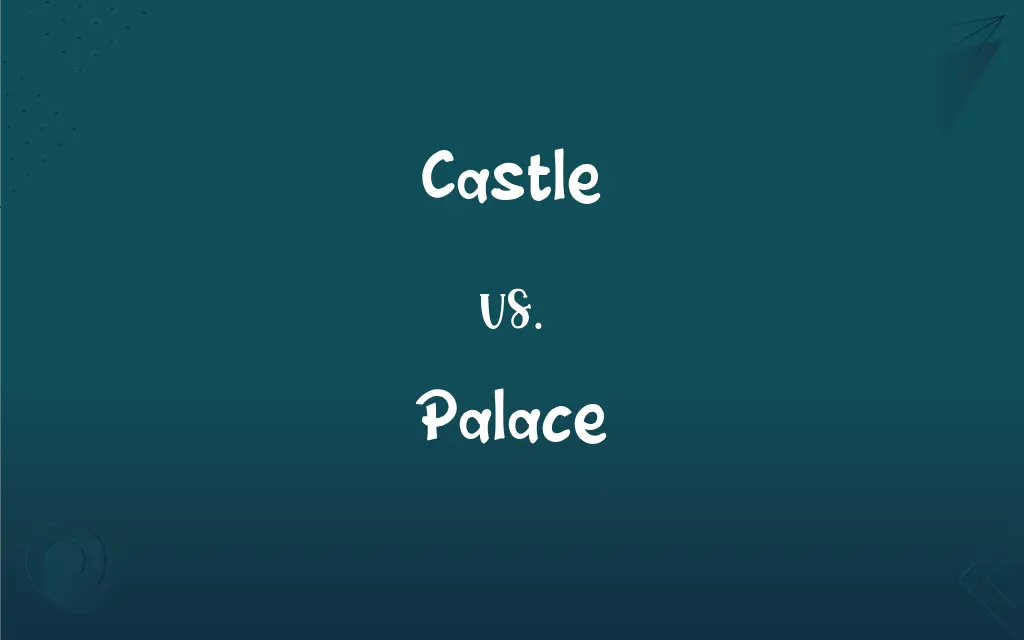Castle vs. Palace: What's the Difference?
Edited by Janet White || By Harlon Moss || Updated on July 4, 2024
A castle is a fortified structure built for defense, while a palace is a grand residence for royalty or nobility, emphasizing luxury and comfort.

Key Differences
A castle was primarily built as a defensive stronghold, often featuring walls, towers, and moats to protect against enemy invasions. In contrast, a palace was constructed as a symbol of power, wealth, and grandeur, meant for the luxurious living of royalty and nobility.
Castles are characterized by battlements, drawbridges, and turrets, reflecting their defensive nature. On the other hand, palaces might have lavish gardens, ornate rooms, and expansive courtyards, signifying opulence and splendor.
Throughout history, the construction of castles was crucial in times of warfare or political instability. Palaces, however, often represented periods of peace, prosperity, or cultural renaissance where aesthetic and comfort took precedence.
Castles were strategically located—on hilltops, near borders, or overseeing critical routes—to maximize defensive capabilities. Palaces were often situated in urban or scenic areas, providing both accessibility and aesthetic appeal.
While some castles remain as ruins or historical monuments, others have been transformed into hotels or museums. Palaces still might serve as official residences, while many are tourist attractions showcasing architectural marvels and historical artifacts.
ADVERTISEMENT
Comparison Chart
Primary Purpose
Defense against enemies
Luxurious residence for royalty/nobility
Key Features
Battlements, moats, and drawbridges
Lavish gardens, ornate rooms, and courtyards
Historical Context
Built during warfare or political instability
Represented periods of peace and prosperity
Location
Strategic points like hilltops or borders
Urban or scenic areas for accessibility and beauty
Modern-Day Usage
Historical sites, hotels, or museums
Official residences or tourist attractions
ADVERTISEMENT
Castle and Palace Definitions
Castle
A large, robust structure often associated with royalty.
The castle's architecture reflects the power of its ancient rulers.
Palace
A grand residence of a king, queen, or noble.
The palace was filled with artwork from around the world.
Castle
A residence fortified against attacks.
The castle was built to safeguard the city's inhabitants.
Palace
A luxurious and expansive dwelling emphasizing opulence.
The palace's gardens were a favorite spot for the royals.
Castle
A fortified building or set of buildings.
The castle on the hill has withstood many battles over the centuries.
Palace
An official residence of a sovereign or bishop.
The palace was buzzing with activity during the official ceremony.
Castle
A stronghold built for defense in medieval times.
The castle's walls were thick enough to repel any invasion.
Palace
A symbol of wealth, power, and cultural significance.
The palace remains a testament to the empire's golden age.
Castle
A symbol of feudal power and defense.
The castle stands as a reminder of the medieval era's challenges.
Palace
A large, ornate building often set in beautiful surroundings.
Tourists flocked to the palace to admire its architecture.
Castle
A large fortified building or group of buildings with thick walls, usually dominating the surrounding country.
Palace
The official residence of a royal personage or other high dignitary.
Castle
A fortified stronghold converted to residential use.
Palace
A large or splendid residence.
FAQs
Were castles always residences for royalty?
Not always. While some castles housed royalty, many were military strongholds or noble residences.
How were castles protected from sieges?
Castles used walls, towers, drawbridges, and strategic location to defend against sieges.
Why are palaces often located in cities?
Palaces were built for accessibility, showcasing power, and proximity to administrative hubs.
Are all castles ancient structures?
Most castles hail from medieval times, but some modern structures mimic castle designs.
Did every country have castles?
Castles are common in many countries, especially in Europe, due to historical warfare and feudal systems.
What materials were used to build castles?
Stone, bricks, and sometimes timber were commonly used in castle construction.
Were castles built only for military purposes?
While defense was a primary reason, castles also symbolized power and authority.
What activities take place in a palace?
Besides being a residence, palaces might host ceremonies, events, or administrative functions.
What was the primary function of a castle?
A castle was primarily built for defense against enemies.
How is a palace different from a castle in terms of luxury?
A palace is designed for luxury and comfort, while a castle emphasizes fortification.
Can a palace have defensive features?
While some palaces may have defensive elements, their primary purpose is luxurious living.
How have castles influenced modern architecture?
Castles have inspired designs, themes, and even entire resorts in contemporary times.
What distinguishes a palace's architecture?
Palaces often feature ornate designs, grand rooms, and lavish gardens, emphasizing opulence.
Are palaces exclusive to monarchies?
While associated with monarchies, palaces also exist in republics as grand residences or ceremonial buildings.
How are palaces maintained today?
Many palaces are maintained by governments or trusts, funded by tourism or official allocations.
Why do tourists visit palaces?
Palaces attract tourists due to their historical significance, architecture, and artifacts.
Do all palaces belong to royal families?
Most palaces were built for royalty, but some belong to nobles or have been repurposed.
Why did castles have moats?
Moats provided an additional defensive barrier against attackers.
Can a building be both a castle and a palace?
Some structures, like the Tower of London, have elements of both and have served as both.
Are castles and palaces protected as heritage sites?
Many are protected due to their historical, cultural, and architectural significance.
About Author
Written by
Harlon MossHarlon is a seasoned quality moderator and accomplished content writer for Difference Wiki. An alumnus of the prestigious University of California, he earned his degree in Computer Science. Leveraging his academic background, Harlon brings a meticulous and informed perspective to his work, ensuring content accuracy and excellence.
Edited by
Janet WhiteJanet White has been an esteemed writer and blogger for Difference Wiki. Holding a Master's degree in Science and Medical Journalism from the prestigious Boston University, she has consistently demonstrated her expertise and passion for her field. When she's not immersed in her work, Janet relishes her time exercising, delving into a good book, and cherishing moments with friends and family.































































